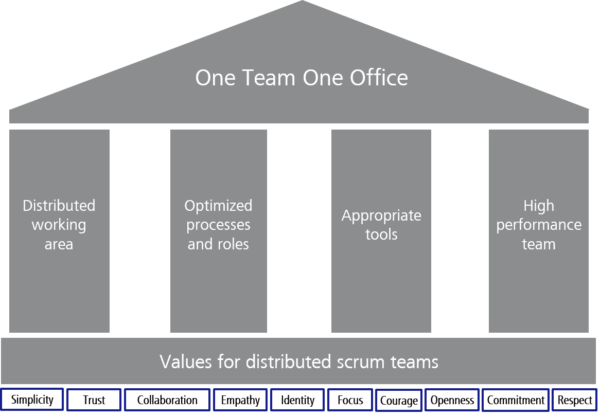While observing social distancing, video conferencing with friends has replaced going down to the pub. During one the subject of how corona influences our work life, popped up very fast.
The consensus was, that the ability to work was greatly impacted and that for some it even had completely disappeared. Their employers were simply not able to supply the necessary infrastructure. And even after the infrastructure eventually was set up the reality set in: It is complicated! Who may talk? Camera on or off? Please mute your microphone the kid is screaming in the background! You want to talk? Please un-mute you microphone! The connection is bad I only get every second word… The list is endless.
People simply are not used to working like this. Not least, because communication is more than exchanging words. During phone and video conferences the interpretation of body posture, facial expressions and gestures is far harder. That is a new situation, which requires great discipline and change in behaviour by all participants!
The discussions carry on and they alternate between reviews of video tools and how working in this situation is impossible. Meanwhile I am frantically searching for something to add to the discussion. But no matter how much I search, I only find one answer to the question “What has changed in your work situation since COVID-19?”, “Nothing really“.
Admittingly that is a slight exaggeration! The commute, the collective lunch break with the colleagues, the chat at the coffee machine – all this currently does not take place, and these are drastic changes and great losses. For people like me where home office is also a day-care and both parents work full time, distributed work can become quite a challenge.
But even in this situation the starting point is the same for everyone. So, you only have the choice to accept it and make the best of it. This shows how important it is to have gathered experience with working in distributed settings.
ZEISS Digital Innovation (formerly Saxonia Systems AG) has been following the basic principals of working in distributed teams for years. Not least to ensure a healthy work-life balance for the employees, it is important for companies to ensure that services can be provided from basically everywhere. This keeps travel expenses low and ensures that the necessary infrastructure does not have to be provided by the customer.

During the five years that I have been working for ZEISS Digital Innovation I have only encountered one project, that united the complete development team at one site. My current project, that was started in September 2019, is extremely distributed, the six project members of ZEISS Digital Innovation are split between five sites and the project stakeholders are at two sites. Therefore, the distribution existed pre-COVID-19 and was identified as a project risk to be addressed.
In my view this was achieved with a simple sounding solution: direct communication.
The developers often used pair programming to not only ensure knowledge transfer, but also to get to know the programming style of the other developers. Apart from this, code reviews belong to our standard procedure. These are not only a quality assurance measure, but also distribute knowledge throughout the team. Beside the daily meeting for all project members, we also have established a “DEV-Daily”, in which the developers can focus on mainly technical issues.
Business requirements are mapped to technical solutions during regular refinement meetings. Ideas are collected, checked, adapted, discarded and created in no-holds-barred discussions. This leads to an area of creativity and free development, that all team members can contribute to, which in turn feel valued and included. Even during the distribution of the team, a real team spirit has developed!
The establishment of this open communication culture has led to a more intensive and frequent communication within the team. Be it one-on-one or in a larger group. One must always carter for the preferences of the individual team members. Some are early birds, at 8 o’clock they are fully in their flow, bursting with ideas to present to their colleagues, some barely can open their eyes at that time in the morning. Some need planned meetings to have time for preparation, others easily hop between subjects and you can call them anytime.
To be honest, it is not enough to simply communicate more, to work efficiently in a distributed environment. Rather an elaborate concept is necessary, that takes all the aspects and challenges of distributed work into account. This is especially important for teams with little experience with distributed work.
Several years ago, ZEISS Digital Innovation already received attention with their ETEO-concept. ETEO (“Ein Team Ein Office” – One Team One Office) is a framework for distributed work in teams. It gives project teams a guide as to how distributed work can be achieved. A permanent video link between the sites and a digital work board for task assignment enables the teams to work spread out between different sites. Just like being at one site together. The video link is no requirement it is just a building block from ZEISS Digital Innovation’s toolkit for distributed work. There are specifically trained employees (ETEO-Coaches), that train and coach the team members, in techniques for distributed work, during ramp up and the project duration. It often leads to a “aha moment” with our customers that distributed work without performance impact can work.

In general, as with everything the rule applies, the tool is nothing, if you do not know how to use it. With this I mean that distributed work can only work with the discipline and right mindset of the involved. One thing is left to be stated, you have to commit yourself without reservations and just try the tools and techniques. And of course: Practice makes perfect. The longer a team works in a distributed environment, the stronger the best practices for distributed work are highlighted in the individual team setting. One must not forget that there is no such thing as the ultimate concept for distributed work. Interactions within projects are not between roles and responsibilities but between people and they are all different.
Each project is different and therefore also the requirements for distributed work. But the basic principles are basically the same. This can be compared with building a house. No matter how it looks, number of floors or type of roof it has, it always has a foundation it rests on.
The foundations of distributed work at ZEISS Digital Innovation are sound.